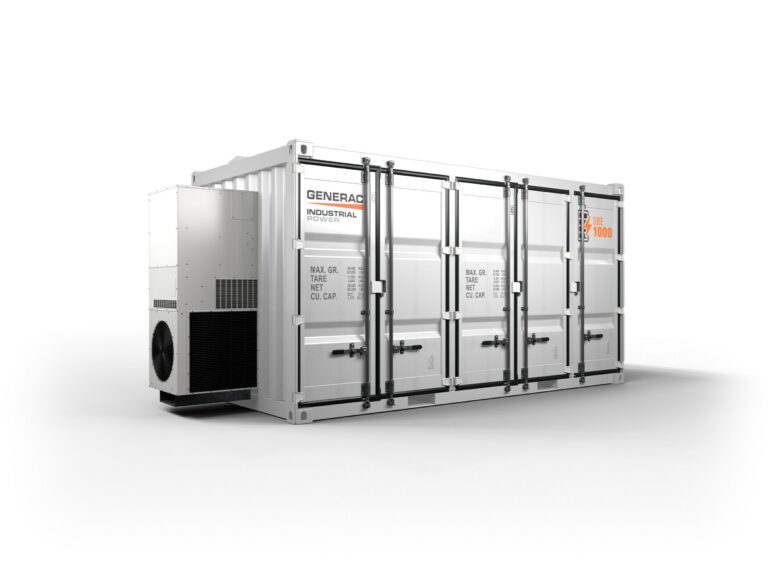
Generac’s SBE Series BESS. Image: Generac Power Systems
Utility Xcel Energy has launched a ‘no money down’ resiliency offering for commercial and industrial (C&I) customers in Minnesota, promising 99.9% power reliability with technologies including batteries.
Meanwhile technology and equipment providers Generac and Urban Electric Power are also targeting what has traditionally been the slowest moving segment of the US energy storage market.
The US industry installed 1,067MW of energy storage in Q4 2022, but just 48MW of those were categorised as commercial and industrial (C&I) or community-scale projects, according to a recent report from Wood Mackenzie Power & Renewables.
Adding up to 195MW total in that category for the whole of 2022, versus 593MW of residential deployments and 4,006MW of grid-scale, illustrating the contrasting fortunes of the segments. Wood Mackenzie has said that while it will remain the smallest segment, all segments of the market are set to grow and has forecast 1.4GW of annual installs for C&I or community projects in the US by 2030.
Minnesota Public Utilities Commission approves Xcel programme
Xcel Energy’s new ‘energy-as-a-service’ resiliency offering targets large heavy commercial and industrial users of electricity in its Minnesota service area, where Xcel acts as one of four investor-owned utilities in the state.
The utility said yesterday (24 April) that it has been granted approval to offer its programme to own, install, operate and maintain microgrids and other resiliency projects for C&I electricity users with high requirements for service reliability, such as factories, water treatment centres or even hospitals and schools.
Xcel’s projects will include battery energy storage, onsite renewables and thermal backup generators. Called Empower Resiliency, the utility will provide a turnkey solution and finance the upfront cost. Customers will pay that money back over an agreed period of time, which was not disclosed in a release but is typically 10 years for Xcel’s Empower Resiliency offering in neighbouring Wisconsin.
Xcel Energy VP of customer solutions and innovation Emmett Romine said the programme “greatly reduces the upfront cost for customers who would benefit from resiliency assets and provides our extensive support to operate and maintain these systems, so they are available if they are needed”.
Xcel has been exploring using microgrids powered by solar and batteries through pilots for a while and executives have spoken in favour of the technological combination, including this quote from CEO and chairman Ben Fowke being included in a 2021 US National Renewable Energy Laboratory (NREL) briefing report on microgrids for resiliency.
“We do want to see the role that microgrids can play on the bigger grid, supporting the bigger grid,” Fowke said.
“I would say that what we’re learning is just that—how we can integrate microgrids into the larger grid and do that seamlessly.”
Zinc batteries picked for C&I virtual power plants
In related news, zinc-manganese dioxide battery storage company Urban Electric Power’s technology has been signed up by commercial and industrial virtual power plant (VPP) provider Maplewell Energy.
Maplewell offers energy-as-a-service (EaaS) to C&I customers through aggregating their distributed energy resources (DERs) into fleets, unlocking flexible demand from DERs that include battery storage, solar PV, HVAC, demand response, refrigeration and more.
Starting with three pilot projects, the VPP operator will onboard Urban Electric Power’s rechargeable zinc batteries with Maplewell’s energy management system (EMS), called JANiiT. JANiiT provides integrated forecasting, predictive control, and real-time optimisation based on gathered data feedback.
Customers will be offered a turnkey battery energy storage system (BESS) solution which will perform demand charge management and demand response in real-time. Maplewell CEO and co-founder Matt Irvin said the selection of Urban Electric Power’s battery came “after an exhaustive review of battery technology”.
Urban Electric Power’s battery is described by the company as an improved version of the typical alkaline electrochemistry found in AA batteries which overcomes some of the limitations of the common consumer electronic battery.
One of those limitations is lifetime, and the startup claimed its patented chemistry enhancements make the batteries rechargeable for lifetimes of 10 years or more. They are also certified safe for indoor installation, and unlike lithium-ion batteries do not risk thermal runaway and contain no cobalt.
In May 2022, Urban Electric Power signed a Memorandum of Understanding (MoU) with US large-scale project developer Pine Gate Renewables to supply up to 4,550MWh of its battery storage over five years, giving Pine Gate preferential terms for acquiring the patented zinc batteries for co-located or standalone grid-scale projects.
Generac launches 200kW to 1,000kWh C&I BESS
Meanwhile, backup generator and portable power specialist Generac earlier this month launched its first BESS solution aimed at medium to large C&I electricity users.
Called the SBE series, the systems range in available energy capacity from 200kWh to 1,000kWh. They will be suitable for applications including demand charge reduction a.k.a peak shaving to reduce a facility’s exposure to peak electricity costs and load shifting to benefit from utility time-of-use electricity tariffs.
At the same time, they will be able to provide some resilience and backup in the event of grid outages or other electrical service disruptions. It is designed to be able to pair with Generac’s existing range of gas and diesel generators to ride out long outages.
It’s the latest move into the energy storage space from Generac, which in addition to a residential range of battery storage products also has its own grid services divison, formed after the acquisition of distributed energy resources (DER) aggregation software provider Enbala.